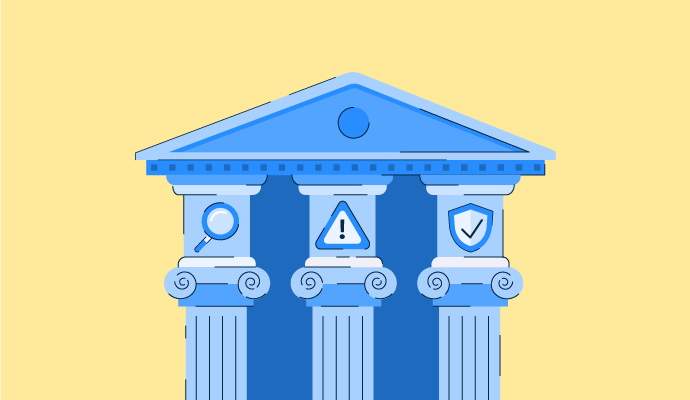November 23, 2022
 by Lauren Pope / November 23, 2022
by Lauren Pope / November 23, 2022

This isn't revolutionary, it's a requirement.
GRC stands for governance, risk management, and compliance, but the true definition goes far beyond that. Companies invest in GRC to achieve business goals with reliability, certainty, and accordance with necessary compliances.
GRC isn’t a difficult concept to understand. It’s familiarizing yourself with all the pieces of the puzzle that go into GRC that can get tricky. Once you understand what GRC is and the right GRC platforms for your organization, a seamless GRC strategy is not far away.
Governance, risk management, and compliance (GRC) is the term used to describe an organization's approach to addressing risks, staying compliant with the law, and managing company direction.
GRC involves the entire organization and requires cross-departmental involvement and buy-in from entry-level employees to the C-suite.
More risk, more adventure - but not in this context.
GRC programs enable business leaders to make better decisions even in risky market conditions and corporate environments. Think of GRC as the company glue that brings the entire organization together to develop and implement policies and actions that comply with set standards.
Every industry has a set of regulations that companies are supposed to follow for streamlined operations and ethical decision-making. GRC strategies are key to ensuring said regulations are not only being considered but also being implemented.
peak devResponsible operations strengthen overall company culture and set a tone for the organization's value system. Such a working environment promotes growth and guides how employees view decision-making and planning at every level.
Incorporating GRC principles and platforms are integral to making business decisions backed by tried and tested rules and frameworks. By providing resources to leaders for communicating risks, planning audit tasks, and performing compliance management, GRC strategies help make better decisions in a shorter time period.
Better data is almost always followed by improved data security measures. A GRC strategy provides controls to protect business and customer data by securing private information.
As the use of technology continues to increase, it is imperative to guard assets against security attacks that may threaten users' data and privacy. GRC also plays a vital role in ensuring companies operate per regulation authorities such as the General Data Protection Regulation (GDPR).
When most people hear the word governance, they think of the federal government or how a country governs itself. While that’s not what we have in mind when discussing corporate governance, the two are more similar than you might think!
Corporate governance is the framework of rules, regulations, and practices by which a company operates. Often, a corporate governing body comprises a company’s senior leadership, board of directors, and company shareholders. They work together within a system of checks and balances to fulfill various corporate governance functions.
In the same way, the federal government keeps everything on track for our country, corporate governance ensures that a company stays the course by ensuring compliance with the law, accountability, fairness, and transparency in a company’s relationship with all major stakeholders.
One of the functions of a corporate governing body is to identify, address, and prevent potential risks to the company. Several things can pose a risk to a business, and managing those risks is part of a comprehensive enterprise risk management strategy.
Enterprise risk management is a business strategy designed to identify, assess, and prepare for any dangers, hazards, and other potential for disaster that may affect an organization's operations and objectives.
Risk management is a complicated job that requires multiple stakeholders and involvement from different departments – because of this, most companies will employ a third-party risk management consulting agency or tools like an operational risk management software, and environment health and safety software.
Regardless of how you manage your risk management strategy, it’s important to have one to ensure the longevity of your business. Preparing for potential problems will help your company succeed in the long run.
In business, compliance is adhering to the rules, policies, standards, or laws set forth by the company you work for or a governing body.
Corporate compliance refers primarily to compliance with rules and regulations an individual company sets. This can include the business ethics or employee code of conduct created by a corporation. Because businesses set these standards for themselves, they vary depending on where you work.
Regulatory compliance is a little different in that it refers to how a company follows all the laws and regulations that apply to its business. These are set by larger governing bodies and are universal rules mandated for each industry.
While compliance is required for all industries, there are somewhere staying compliant is crucial in a day-to-day setting. Healthcare professionals must stay compliant with the Health Insurance Portability and Accountability Act (HIPPA) and protect patient information, financial institutions have a special set of laws they have to follow, etc.
Your business can face many compliance risks, not all of which come from protecting information or user data. A compliance risk can be anything that puts the company at risk.
Much like risk management, compliance is a complicated process. Many companies employ the help of a Chief Compliance Officer whose sole job is to maintain compliance. Other companies use software like G2 Track to track contracts, secure company data, and stay compliant.
Whatever your strategy includes, compliance is a massive undertaking that requires special care and attention. It pays to be organized and communicate with your team.
The more you know: Learn about the five types of compliance audits and why you might need them.
Now that you understand GRC, you might wonder who at your company should be involved with it. Depending on their job description, multiple stakeholders should be part of the GRC process.
If your company employs a chief compliance officer or risk management professional, they should be central in leading other employees in implementing GRC. This can be done through best practices, software usage, and compliance training.
The best GRC software help mitigate financial and legal risks by evaluating organizational strategies and business liabilities. The technology records and tracks risk information and incidents and is beneficial when companies need to modify their operations as per regulations.
To be included as a software solution within this category, a product must:
* Below are the top 5 leading employee monitoring software solutions from G2’s Fall 2022 Grid® Report. Some reviews may be edited for clarity.
AuditBoard is a connected risk platform with a unified data core that centralizes your organization's risks, controls, policies, frameworks, issues, and more. The tool helps businesses leverage risk as a strategic driver.
“We love seeing our organization's ecosystem of risks and controls. The platform's automation capabilities allow us to schedule tasks ahead of time and even collect information automatically in some instances. This allows us to use our resources better and be prepared before starting a project versus waiting until we have started.
The insights on the dashboards provide additional value and robust reporting for Executive Management. Also, seeing results and evidence year over year in a centralized portal with associations to the controls is beneficial in an ever-changing workforce."
- AuditBoard Review, Melissa P.
“Some of the changes or patches get implemented into each program (OpsAduit, Risk Comply, etc.), and it's not beneficial to do this as it can cause confusion and more time spent on unnecessary action items.”
- AuditBoard Review, Justine M.
LogicGate Risk Cloud is a scalable, adaptable, no-code GRC platform for changing business needs and regulatory requirements. Its intuitive applications allow professionals to develop and communicate leading risk strategies.
“I've used several platforms like this for risk management, especially third-party risk. LogicGate is BY FAR the most customizable application of them all. If you can determine the logical flow, you can add about anything.
I used to perform risk acceptance forms in a separate doc platform, then moved it over to the platform. I was able to create the form and electronic signature in the application and insert it into the current workflow seamlessly.”
- LogicGate Risk Cloud Review, Aaron M.
“The creation of applications can be counterintuitive from a hierarchical point of view. The forms seem to be created more from a design POV. Data points should be created as an "on-the-fly" option.
Creating groups for communication distribution should be more integrated into the application view/job view to preview who the distribution is being sent to. Certain options such as access views and contact collections should be made more straightforward.”
- LogicGate Risk Cloud Review, Rebecca S.
A GRC software with integrated solutions for the entire risk life cycle, Ncontracts simplifies compliance and improves productivity. Users can choose from existing modules or build their own risk management system.
“I like the easy access to all the things we need quickly. Keeps us all on the same page with upcoming dates and branch and employee information. It is overall just a nice tool to have, especially when there's a lot going on, and you need instant access to documents.”
- Ncontracts Review, Brianna V.
“If I had to pick something, I would say it would be the search functionality. It is not quite as intuitive as I thought it would be after learning about it from our representative. I would like it to function more like Google, especially when searching for keywords within documents.”
- Ncontracts Review, Megan B.
ZenGRC is a cloud-based SaaS solution to elevate a company's risk and compliance programs to the highest infosec standards. The platform provides continuous monitoring and customizable audit management capabilities for risk management.
“ZenGRC makes it easy to map objects between frameworks, programs, risks, and vendors, which reduces labor duplication and provides insight into the impacts of making positive changes. The onboarding program is outstanding, giving new users a strong foundation for the basics of the platform and confidence in their workflows.”
- ZenGRC Review, Rob C
“The current user interface can be improved.
The report extracts and one view look need to be improved. The platform has too many tabs under the same control/risk/issues.
The platform doesn't have role-based access. Eg: A control owner with editor access can edit policies and risks, which is not a great way to implement segregation of duties."
- ZenGRC Review, Kanupriya P.
Hyperproof is a security compliance management software to help teams stay on track with compliance and risk management. The tools provide the capability of adding new frameworks as businesses scale to manage the ever-growing compliance workload.
“Hyperproof allows us to automate the evidence collection across multiple controls and track progress in an intuitive yet powerful user interface. Their platform is easy to set up right out of the box and requires minimal configuration.
The software introduces the concept of "freshness," a unique way to track current evidence, and uses integrations with standard applications, such as Google Workspace and AWS, to retrieve proof automatically. These features and others allow my team to focus on other security initiatives!”
- Hyperproof Review, Jian G.
“The tool is a work in progress. That said, the Hyperproof team is always taking feedback for features and working to build those out quickly.
A pain point for me is there's not much information on the dashboards/analytics, and we can't perform risk assessment using the tool. It would also be nice to have a policy management feature.”
- Hyperproof Review, Tia C.
Building a GRC strategy doesn't have to be a long-drawn and complicated business action. Think about what your company already does well and create a plan to fill in the gaps. Remember that you can always use third-party GRC consultants or use a compliance software program to make your job easier.
If your business is already GRC-ready (yay!), it's time to think about mitigating risks during emergencies. Learn about business continuity and how it reduces the impact of risks and helps during downtimes.
Lauren Pope is a former content marketer at G2. You can find her work featured on CNBC, Yahoo! Finance, the G2 Learning Hub, and other sites. In her free time, Lauren enjoys watching true crime shows and singing karaoke. (she/her/hers)
I’ve always believed chaos is just a sign of a missing system.
 by Harshita Tewari
by Harshita Tewari
Every time I sit down with my InfoSec team, one thing becomes clear: managing governance,...
 by Soundarya Jayaraman
by Soundarya Jayaraman
Recently, I underwent a critical customer escalation. I mentioned their product in a different...
.png) by Shreya Mattoo
by Shreya Mattoo
I’ve always believed chaos is just a sign of a missing system.
 by Harshita Tewari
by Harshita Tewari
Every time I sit down with my InfoSec team, one thing becomes clear: managing governance,...
 by Soundarya Jayaraman
by Soundarya Jayaraman


